The week at a glance
- White-crowned Sparrow still in Norfolk
- Pacific Diver still in Pembrokeshire
- Barrow's Goldeneye still in County Down
- Wilson's Snipe again on Scilly
- American Buff-bellied Pipit still in County Cork

White-crowned Sparrow, Cley next the Sea, Norfolk (Photo:
Dave Hutton)
Some beautiful very early spring weather was very much to the fore this week, with temperatures nudging towards those more frequently experienced in April. Much of the news, certainly where the top rarities were concerned, was still very much of a wintry or, more accurately, a wintering feel. Still claiming top billing (any bets on when it will lose the title?) was the White-crowned Sparrow at Cley (Norfolk). Still the birders come, and still they go away pleased as punch to have enjoyed fantastic views of a fantastic vagrant. The second-winter Pacific Diver remained at Llys-y-Fran Reservoir (Pembrokeshire) to 8th. If the bird has departed, it's interesting to note that this individual only arrived on 2nd February last year (lingering to 20th March). Could the mild, almost warm, weather have convinced the bird to head north already? In Ireland, the drake Barrow's Goldeneye was reported from Quoile Pondage (Co. Down) for the first time in two weeks on 9th-12th, while another transatlantic mega - a Wilson's Snipe - was again on the pools at Lower Moors, St. Mary's (Scilly) on 7th, 11th and 13th. Across the Irish Sea to Cork, where the American Buff-bellied Pipit was still at its winter residence of Red Barn Strand, near Youghal on 9th and 11th.
With barely a breath of wind, it's little surprise that so few seabirds of note were recorded this week. A White-billed Diver was again off South Nesting, Mainland (Shetland) on 10th. Three Balearic Shearwaters were noted: two off Durlston CP (Dorset) on 7th and one off Prawle Point (Devon) on 10th were the only records this week. A Sooty Shearwater flew south past Flamborough Head (E. Yorkshire) on 10th. A lone Pomarine Skua was off Dungeness (Kent) on 8th, and the Little Auk was still off Grutness (Shetland) to 10th, with another single at Broadford, Skye (Highland) on 12th.

Cattle Egret, Legbourne, Lincolnshire (Photo:
Mark Ranner)

Cattle Egret, Legbourne, Lincolnshire (Photo:
Matt Latham)
With the approach of spring, thoughts are moving forward towards the possibility that any of the Cattle Egrets still at large, in some numbers, in the southwest of England may emerge as pioneers for the species and breed in this country for the first time. In southeast Cornwall, a flock of 13 were seen at Widegates on 7th (rising from four there from last week), while 20 birds were again at Treganhoe Farm, Sancreed in the far west of the county on 9th (with 21 reported there on 11th). Nine birds were at Crantock on 7th (again up on last week), and eight birds were at Burniere Point, along the River Camel in north Cornwall on 8th (with five over nearby Wadebridge on 11th). One bird remained at Stithians Reservoir to 10th at least. In Devon, one remained at Warleigh Point to 12th and two were seen at Saltram, near Plymouth to 13th. Along at Exminster Marshes RSPB, two birds were still present to 7th (with one there to 13th), while at nearby Powderham, three birds were seen on 8th-10th. Alongside the Kingsbridge Estuary, five birds remained to 9th with one at Otterton on the same date. Three birds lingered at Stretcholt (Somerset) to 10th, and one was still present to the west of Watchet (Somerset) on 12th, while in Dorset a "new" bird was at Frampton on 8th-9th, with another still at Bere Regis to 9th. Three birds were again at Radipole Lake RSPB on 13th. In Hampshire, the lone bird at Harbridge remained to 13th, with another single at New Milton on 8th, with two birds at St. Leonard's Grange on the same date, remaining to 13th. Drifting into West Sussex, where one bird was still to be found near Chichester GP (West Sussex) to 10th and the bird at East Lavant was still present to 13th. Two birds in East Sussex this week: one remained at Piddinghoe until 8th with another at Pevensey Levels on 10th. The singleton at Fretherne (Gloucestershire) was still being seen throughout the week. To the northwest, where a Cattle Egret was seen near Poynton, Macclesfield (Cheshire) on 11th-13th, having been present for several days prior to that date.. The Cattle Egret in Lincolnshire was still in place at Legbourne near Louth to 13th. Irish records tailed off a little this week: four birds were still at Clogheen (Co. Cork) on 9th, while others in Cork were at Curraheen on 7th-10th, Rosscarbery on 10th and at the Lough on 11th-13th. Waterford boasted two birds at Ardmore on 9th-1oth, the latter date seeing a single bird noted near Youghal Bridge, while one was at Akeragh Lough (Co. Kerry) on 10th.
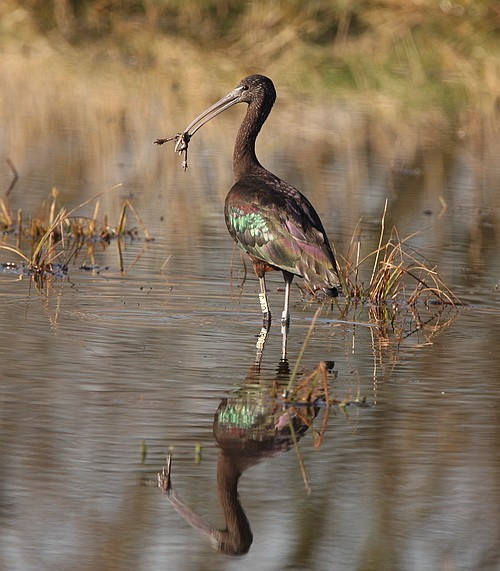
Glossy Ibis, Howden's Pullover, Lincolnshire (Photo:
Dean Eades)

Spoonbill, Ernesettle, Devon (Photo:
Chris Buckland)

Great White Egret, Caldecote, Warwickshire (Photo:
Steve Seal)
At least five Great White Egrets were to be enjoyed this week. At Cotswold Water Park (Wiltshire) one remained from 7th-11th at least, while the bird near Pymore (Cambridgeshire) remained to 12th. In Suffolk, the bird present for several weeks was again at Thorpeness on 10th-11th and others were seen at Rostherne Mere (Cheshire) on 12th-13th, and near Marshside RSPB (Merseyside) on 13th. Perhaps the most popular Great White Egret of the week though was in Warwickshire, present from 8th-12th at least, near Nuneaton. Eleven Spoonbills were at Arne RSPB (Dorset) on 10th, while seven continued their stay at Isley Marsh RSPB (Devon) to 9th and five were at Wacker Quay (Cornwall) on 11th.Up to half a dozen were noted elsewhere, including singles on Scilly, in West Sussex and on Anglesey. The second-winter Spanish colour-ringed Glossy Ibis remained very popular throughout the week, still present around Saltfleet to 13th. The similarly aged long-stayer at Warton Marsh (Lancashire) was still in place on 9th-13th. In Moray, the 11 Common Cranes could still be seen near Elgin to 13th, while three were still in Highland, at Hastigrow, to 8th. A Common Crane was seen again at Welney WWT (Norfolk); also on 8th-11th and four birds were reported near Braintree (Essex) on 13th. An adult Night Heron was seen at Mere Sands Wood LWT (Lancashire) on 12th, but couldn't be relocated the following day.

Black Brant, Newtownards, Down (Photo:
Derek Charles)
The gentle push towards the northwest continued this week for at least one more Ross's Goose, a bird appearing in Cumbria, at Anthorn, on 10th, remaining in the nearby area to 13th (also being seen at Easton and Campfield Marsh RSPB). In Lancashire, last week's mover, the bird at Stalmine, was still present to 12th. This bird is definitely known to have been residing in Norfolk for much of the winter - its black secondaries the giveaway field-mark to prove the fact. In Norfolk, the two adult Ross's Geese found last week on Halvergate Marshes were seen again, together, on 9th. One was seen near Martham, emerging from its night-time roost, early on 7th. Snow Geese were represented by the still-present first-winter near Rennibister, Mainland (Orkney) to 10th, with the bird on Argyll, at Craobh Haven; also present to the same date. An intermediate morph was at Fetterangus (Aberdeenshire) on 7th-8th, then north of the Ythan Estuary, at Slains, on 11th-13th. A white Snow Goose was reported at Heigham Holmes (Norfolk) on 9th and 11th-12th, with another white bird (of unknown origin) at Mickle Mere (Suffolk) on the same date. A "Richardson's" Canada Goose was still at Ballyconnell (Co. Sligo) on 9th. The adult Red-breasted Goose was seen at Thorney Island (West Sussex) on 12th. Five or six Black Brants remained in Norfolk (including at least three adults at Cley NWT on 12th), with others remaining in Devon, Hampshire, Essex and West Sussex. One was also seen in Ireland, at Newtonards (Co. Down) on 10th-12th.
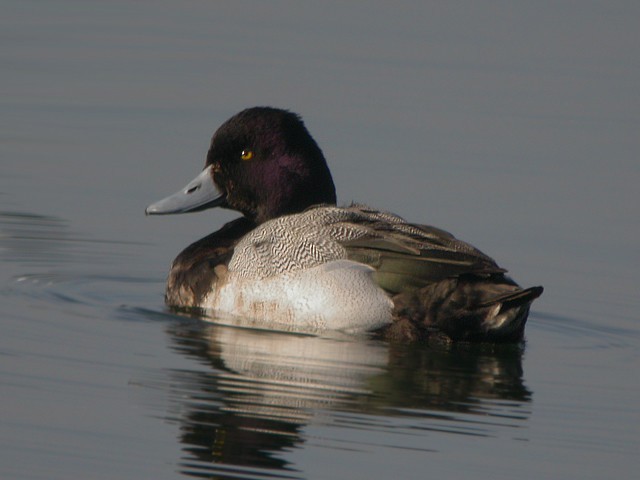
Lesser Scaup, Draycote Water, Warwickshire (Photo:
Bob Hazell)

Green-winged Teal, Marshside RSPB, Lancashire (Photo:
Richard Fox)

Ferruginous Duck, Loscoe Dam, Derbyshire (Photo:
Bob Hazell)
Four drake American Wigeon lingered this week: at Angle Bay (Pembrokeshire), on Loch Bee, South Uist (Outer Hebrides), near Wick (Highland) and at Maywick (Shetland). Nine drake Green-winged Teal were reported during the week - one was at Marshside RSPB (Merseyside) on 9th-13th, along with others in Northumberland (at Woodhorn Flash), in Ayrshire (at Seamill), on North Uist (at Loch Mor), Shetland (at Loch of Tingwall) and mainland Orkney (on the Loch of Tankerness). In Ireland, birds remained in Bell Harbour (Co. Clare), at Belfast Lough RSPB (Co. Antrim), and at Kilcoole (Co. Wicklow), all to 10th at least. The presumed hybrid drake Green-winged Teal x Eurasian Teal was still at Salthouse (Norfolk) to 9th. Three drake Garganey were seen this week: one was still present at Carrickgreenan (Co. Cork) on 7th, with new finds at Cotswold Water Park (Wiltshire) on 11th and at Lochmaben (Dumfries & Galloway) on 13th. Drake Lesser Scaup continued to be seen at Appleford Gravel Pits (Oxfordshire), Draycote Water (Warwickshire), Loch Leven (Perth & Kinross), Coot Loch, Benbecula (Outer Hebrides) and Lough Arrow (Co. Sligo) this week, while the only female, on Yell (Shetland) was present to 12th. Ring-necked Ducks mustered nine birds - regular winter fixtures lingered in Somerset and Buckinghamshire (drakes), with others remained in Cornwall and Cumbria (ducks). Five birds were in Ireland, including a new arrival in County Donegal, at Glenveagh National Park, on 7th. The drake Ferruginous Duck present near Heanor (Derbyshire) was reported to 9th. In Aberdeenshire, the first-winter King Eider was still bobbing around off the coast at Girdle Ness (Aberdeenshire) to 9th and the adult male remained on Mousa (Shetland) to 10th. The week, nine Surf Scoters were reported: the first-winter females remained off Dawlish Warren (Devon), Tiree (Argyll) and Silver Strand (Co. Galway) and single drakes were in Fife and Orkney to 13th, with a new bird seen off Dornoch (Highland) from 11th-13th. Three birds (including two drakes) were noted in the Sound of Taransay (Outer Hebrides) on 13th.
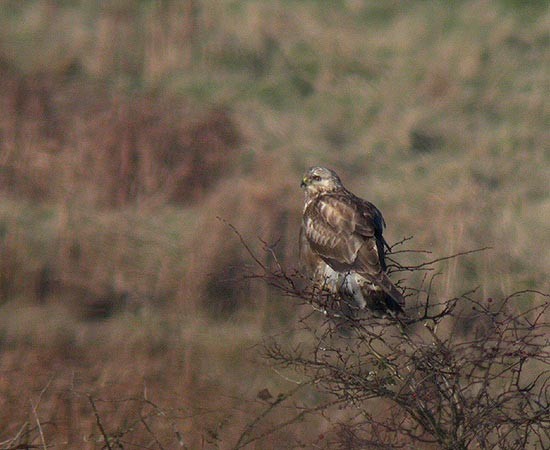
Rough-legged Buzzard, Burnham Norton, Norfolk (Photo:
Craig Shaw)
Several Rough-legged Buzzards this week, including wintering birds on the Isle of Sheppey (Kent), around Sleddale and Commondale, on the Cleveland/North Yorkshire border and on Orkney too. One was reported flying over Swallow Moss (Staffordshire) on 8th, with one then seen in Derbyshire, at Clowne, on 10th. In Norfolk, one was seen at various sites along the north coast between 9th and 12th.
The Spotted Sandpiper continued to be seen around the Lisvane Reservoir area (Glamorgan) to 13th. The first-winter Long-billed Dowitcher found last week at Langton Herring (Dorset) was still present to 11th and the first-winter at Bowling Green Marsh RSPB (Devon) was seen again on 11th. Three Lesser Yellowlegs were noted over the past few days: at Southwold (Suffolk) on 8th-9th, at Rosscarbery (Co. Cork); also on 8th-9th and still around the Montrose Basin (Angus) from 9th-12th. The wintering adult Temminck's Stint was again seen Slimbridge WWT (Gloucestershire) on 7th and 12th.
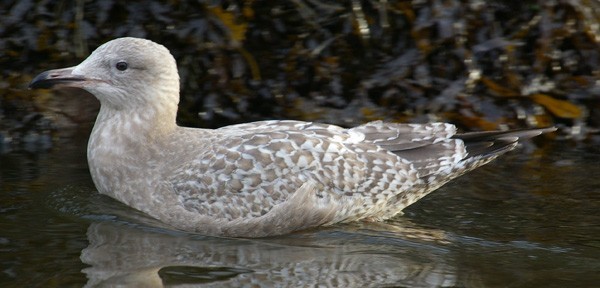
American Herring Gull, Galway, Galway (Photo:
Derek Charles)

Kumlien's Gull, Rossaveal, Galway (Photo:
Derek Charles)
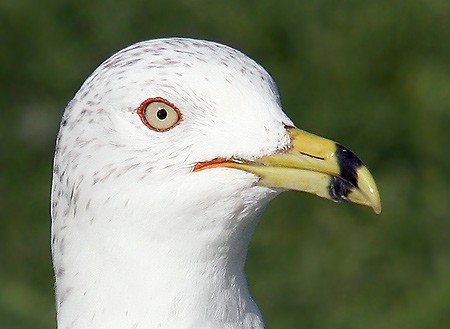
Ring-billed Gull, Gosport, Hampshire (Photo:
Ashley Howe)
The adult Bonaparte's Gull was seen again at Ferryden (Angus) on 9th and the second-winter Franklin's Gull appeared at Chew Valley Lake (Somerset) again on 12th-13th. Over 65 Glaucous Gulls were seen over the past week, again widely scattered across Britain and Ireland, generally singles, but 11 around Ardvichar Point, South Uist (Outer Hebrides) on 10th was exceptional. There were still over 100 Iceland Gulls spread far and wide this week. Double-figure tallies were noted at Mallaig, Highland (11 birds there on 8th), at Nimmo's Pier, Co. Galway (12 birds on 8th), and at Killybegs (Co. Donegal), where 13 birds (including 10 juveniles) were seen on 9th. Also certainly of note were six birds around Kirkwall (Orkney) on 7th, five birds around Newlyn Harbour (Cornwall) on 8th and seven birds at Stornoway Harbour, Lewis (Outer Hebrides) on 9th. The juvenile Kumlien's Gull was still at Mallaig (Highland) to 8th at least, with other juveniles seen at Draycote Water (Warwickshire) from 7th-9th, at Cork City Lough on 7th-9th and Dargan Bay (Co. Antrim) on 10th. A second-winter was at Nimmo's Pier (Co. Galway) on 10th (with two birds reported here on this date) and the third-winter was again at Broomhead Reservoir (South Yorkshire) on 9th. An adult Kumlien's Gull was seen at Moore NR (Cheshire) on 12th-13th. Caspian Gulls were again in relatively short supply this week, as many large gulls continued to exit the country. Fewer than 20 individuals were reported this week, including three at Hole Haven, Canvey Island (Essex) on 7th (an adult and two first-winters) and first-winters at Lytham St. Anne's (Lancashire) on 10th and near Larkhill (Wiltshire) on 13th. At least a dozen Ring-billed Gulls this week included three birds at Nimmo's Pier in Galway on 8th and two birds (a first- and second-winter) at Cork City Lough on 7th. In Scotland, adults were noted at Strathclyde Loch (Clyde) on 9th-10th and at Kinneil Lagoon (Forth) also on 9th-11th. Others noted included adults again at Slapton Ley (Devon), at Llys-y-Fran Reservoir (Pembrokeshire) and Six Mile Water (Co. Antrim). The rather pale juvenile American Herring Gull remained around Nimmo's Pier (Co. Galway) until 13th, and the possible near-adult bird seen off and on at Chew Valley Lake (Somerset) was noted again on 8th. In Cheshire, a striking young American Herring Gull (or impressive lookalike) was at Moore NR on 12th, and could be the bird seen nearby at Richmond Bank on 2nd. An adult Forster's Tern was at Kinvarra (Co. Galway) on 7th-10th.
Last week's Richard's Pipits at Auchmithie (Angus) and Howden's Pullover (Lincolnshire) were seen to 9th and 12th respectively. A new bird was found near Stiffkey Fen (Norfolk) on 9th and remained to 11th at least. The dismal numbers of Waxwings continued into the second week of the month, only some 40 could be found countrywide and this included a flock of some 20 birds in Gateshead (Co. Durham) on 9th-10th. As with last week, a group of 13 birds were still at Longforgan (Perth & Kinross). The Dark-breasted Barn Owl at Wacton Common, near Long Stratton (Norfolk) remained to at least 12th, and another bird was reported at Cotswold Water Park (Wiltshire) on 9th. A Black-bellied Dipper was at Watton, near Tophill Low NR (East Yorkshire) on 11th-13th, and it subsequently transpired that the bird had been around since some time in 2007.

Hume's Leaf Warbler, Stockton-on-Tees, Cleveland (Photo:
Mark Newsome)
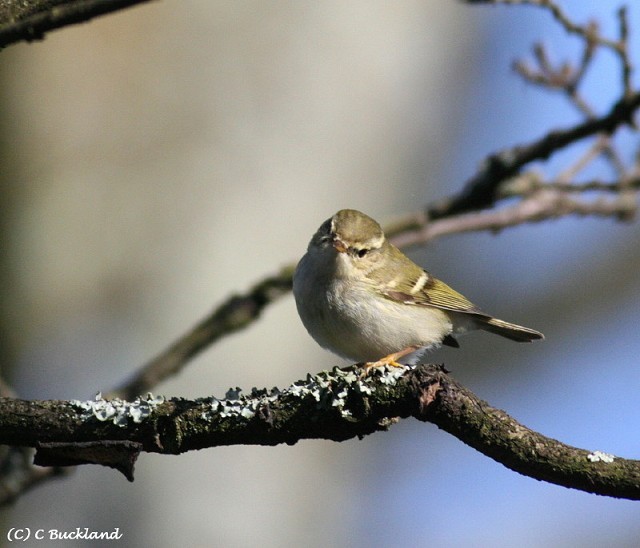
Yellow-browed Warbler, Plymouth, Devon (Photo:
Chris Buckland)
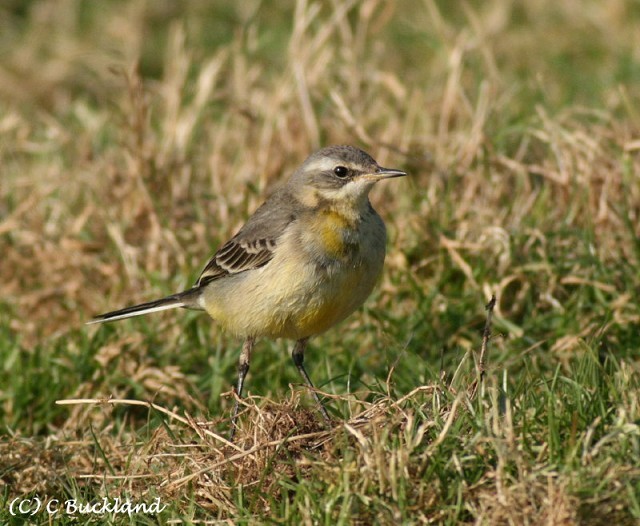
Yellow Wagtail, Trevollard nr Saltash, Cornwall (Photo:
Chris Buckland)
Not a species often associated with February is Yellow Wagtail, but one was seen at Trevollard (Cornwall) on 7th-10th (and was thought to have been present for a week or so prior to this). The bird appeared not to be a standard flavissima, and observers thought that it may be of an "eastern" type. Also in Cornwall, the two Hume's Yellow-browed Warblers continued their temporary winter residences, at Cot Valley and at Tehidy CP, near Camborne, both to 13th. A new Hume's was found at Stockton-on-Tees (Cleveland) on 11th, in what has become an excellent winter for the species (after a dismal late autumn showing). The bird was still present to 13th. Four Yellow-browed Warblers included familiar birds at Jarrow (Co. Durham) and Chew Valley Lake (Somerset), and new finds were birds at Helston (Cornwall) on 7th and in Plymouth (Devon) on 9th, remaining to 13th.

Great Grey Shrike, Forest of Dean, Gloucestershire (Photo:
Lewis Thomson)

Common Rosefinch, Longridge, Lancashire (Photo:
Gavin Thomas)
The glorious weather seemed to nudge the country's Great Grey Shrikes into action this week. Up to 25 birds were seen this week, with five in Norfolk alone (presumably including birds funnelling out of the country). Three counties could boast two birds each (Hampshire, Nottinghamshire and Staffordshire), while one in Herefordshire, at New House Wood on 10th, was certainly of note. A Little Bunting was an excellent find in the far north of Scotland on 12th - a bird trapped and ringed at Noss Head, near Wick (Highland). Rather more surprising (for the second week of February) was the fine male Common Rosefinch, seen briefly in a garden at Longridge (Lancashire) on 9th. A few photographs were taken; the bird looked rather rosy, but sadly, after its flying visit was not seen again. Rounding things off this week, an unsubstantiated report of a male Black-headed Bunting, frequenting rough pasture (with Yellowhammers) at Alvecote Pools (Warwickshire) on 10th. If there really was Black-headed Bunting present (and not an escaped Weaver), it's hard to imagine it could be wild, but who would expect three Garganeys, Night Heron, Yellow Wagtail and a Common Rosefinch all in the same week in February...
Photo of the Week

Glossy Ibis, Howden's Pullover, Lincolnshire (Photo:
Dean Eades)
DeDean Eades has been photographing the birdlife of Lincolnshire for quite some time. With the arrival of a Glossy Ibis on his home patch, he has made a point of documenting its visit, recording a great action sequence as it catches a toad. One of the key techniques of the bird photographer is to use light to highlight the key features in an image. Catching the eye and bill in sunlight is often the aim. The latter was especially important in this case, partly because the bill is such an impressive characteristic of this species, but also because it held the toad in such a distinctive position. The other impressive characteristic of this species is the wonderful iridescent plumage, and Dean has captured this in its full splendour.
Other notable photos

Sparrowhawk, undisclosed site, Norfolk (Photo:
Stephen Durrant)

Short-eared Owl, undisclosed site, Clwyd (Photo:
Tom Charles)
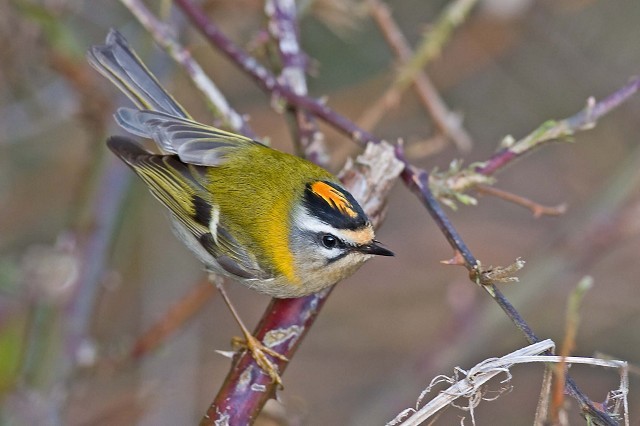
Firecrest, Grafham Water, Cambridgeshire (Photo:
Garth Peacock)

Shoveler, Summer Leys LNR, Northamptonshire (Photo:
Richard Bedford)

Common Buzzard, Spain (Photo:
Steve Fletcher)
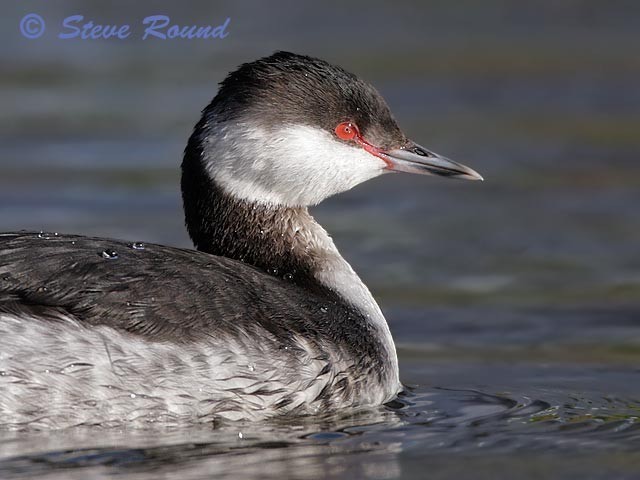
Slavonian Grebe, Barrow Lodge, Lancashire (Photo:
Steve Round)

Siskin, Honingham, Norfolk (Photo:
Mark Skipper)

Starling, Gargrave, North Yorkshire (Photo:
Ray Payne)
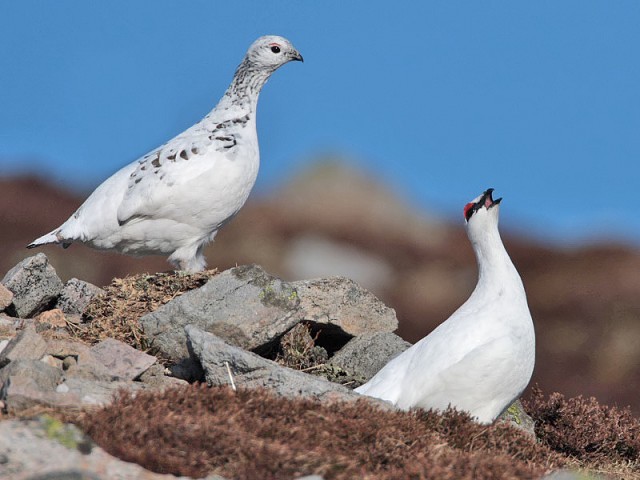
Ptarmigan, Glen Shee, Perth & Kinross (Photo:
John Anderson)

Snow Bunting, Salthouse, Norfolk (Photo:
Peter Simpson)
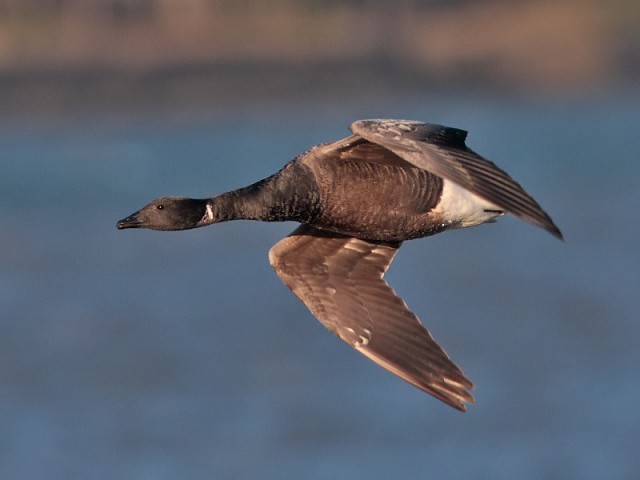
Dark-bellied Brent Goose, Eden Estuary, Fife (Photo:
John Anderson)

